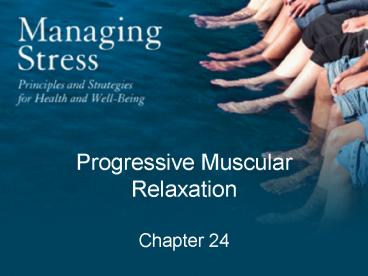Progressive Muscular Relaxation Chapter 24 - PowerPoint PPT Presentation
1 / 13
Title:
Progressive Muscular Relaxation Chapter 24
Description:
Progressive Muscular Relaxation Chapter 24 Relaxation is the direct negative of nervous excitement. It is the absence of nerve-muscle impulse. Edmund ... – PowerPoint PPT presentation
Number of Views:91
Avg rating:3.0/5.0
Title: Progressive Muscular Relaxation Chapter 24
1
Progressive Muscular RelaxationChapter 24
2
- Relaxation is the direct negative of nervous
excitement. It is the absence of nerve-muscle
impulse. - Edmund Jacobson, M.D.
3
An Historical Perspective of PMR
- Edmund Jacobson was a U.S.-trained physician who
noticed that all his patients with illness showed
chronic muscle tension. He theorized that if
muscle tension was significantly decreased, the
chance for illness would diminish. - PMR has proved to be a popular relaxation
technique in the U.S. for many decades. - It may be the only recognized relaxation
technique created in the U.S.
4
Progressive Muscular Relaxation
- The bodys muscles respond to thoughts of
perceived threats with tension or contraction. - Muscular tension is believed to be the most
common symptom of stress, and can lead to - stiffness, pain, discomfort, distorted and
disaligned posture, and joint stability.
5
Progressive Muscular Relaxation (continued)
- The building blocks involved in muscular
contraction are a motor end unit, a motor nerve
fiber (neuron), a skeletal muscle fiber, and a
stimulus from the nerve fiber to the muscle fiber
called an action potential. - Chemicals released from these neurons are
neurotrophic substances. - Neurotransmitters secrete epinephrine,
norepinephrine, and ACh to regulate and control
muscle contraction.
6
Progressive Muscular Relaxation (continued)
- Muscles can contract in one of three ways
- concentrically (shortening)
- eccentrically (lengthening)
- isometrically (no visible change in length)
- Muscle tension produced through the stress
response is primarily isometric. - Over time, muscles contracted isometrically can
begin to show signs of shortening.
7
Progressive Muscular Relaxation (continued)
- Progressive muscular relaxation is a systematic
approach to relieving muscle tension. - Based on the work of Edmund Jacobson, PMR is a
simple technique used to promote rest and
relaxation by systematically tensing and relaxing
the bodys musculature, from feet to the head.
8
Benefits of PMR
- Decreases muscle tension
- As body relaxes, so does the mind
- People who use PMR have less health issues
9
Steps to Initiate PMR
- Find a comfortable position.
- Begin by monitoring your breathing. Inhale when
you contract each muscle group, exhale when you
relax each muscle group. - Focus your concentration on each muscle group as
you work various regions of your body.
10
Typical Phase for Each Muscle Group Using PMR
- First contraction 100 _at_ 510 seconds
- release and relax (exhale)
- compare relaxation to contraction
- Second contraction 50 _at_ 510 seconds
- release and relax (exhale)
- compare relaxation to contraction
- Third contraction 510 _at_ 510 seconds
- release and relax (exhale)
- compare relaxation to contraction
11
Progressive Muscular Relaxation
- Research indicates that anger elicits the
greatest response of unconscious muscle tension.
Progressive Muscular Relaxation is one of the
best techniques to deal with symptoms of anger.
12
Best Application of PMR
- Excellent way to reduce muscle tension
- Thought to be beneficial for people who quit
smoking - Avoid using in areas with chronic pain
- Avoid using if you have hypertension
13
Study Guide Questions
- 1. Explain the rationale for PMR as an effective
relaxation technique. - 2. Describe in simple terms how to begin a
session of PMR to promote relaxation. - 3. What are some conditions where this technique
is not advised?































